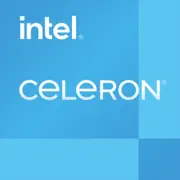Intel Celeron 7300

Intel Celeron 7300: Compact Energy Efficiency for Basic Tasks
March 2025
Introduction
The Intel Celeron 7300 is a budget processor from the 12th generation (Alder Lake) line, designed for ultra-portable laptops. Despite its modest specifications, it has found its niche among users who prioritize battery life and affordability. In this article, we will explore who this CPU is suitable for, how it handles everyday tasks, and what to pay attention to when choosing a device.
1. Architecture and Process Technology
Hybrid Structure of Alder Lake
The Celeron 7300 is built on a hybrid Alder Lake architecture, though in a cut-down configuration:
- 5 cores (E-cores): All cores are energy-efficient (Gracemont), thus ensuring low power consumption. Hyper-Threading is absent — 5 threads.
- Intel 7 Process Technology: A 10nm technology with improved transistor density.
- Clock Speeds: Base clock is 1.0 GHz, maximum in turbo mode is up to 3.3 GHz.
- Cache Memory: 8 MB L3, which is sufficient for simple applications.
Integrated Graphics
- Intel UHD Graphics for 12th generation: 48 EUs (execution units), clock speed up to 1.1 GHz.
- Supports resolutions up to 4K@60Hz, and decoding of AV1 and H.265.
Example: Playing 4K video on YouTube runs smoothly, but gaming in FullHD requires lowering graphical settings.
2. Power Consumption and TDP
TDP of 9W — a key feature of the Celeron 7300. This allows:
- The use of passive cooling or compact coolers.
- The installation of the CPU in ultra-thin laptops (case thickness from 13 mm).
- Minimal heating even under prolonged load.
However, when turbo mode is activated, power consumption briefly reaches 15W, necessitating headroom in the cooling system.
3. Performance in Real Tasks
Office Work
- Microsoft Office, Google Workspace, and browser with 10+ tabs — the processor handles these confidently.
- Running Zoom + simultaneous work in Excel does not cause lags.
Multimedia
- Streaming video (Netflix, Twitch) in 1080p/4K — no problems.
- Simple editing in Shotcut or DaVinci Resolve: rendering a 1080p video will take 2–3 times longer than on a Core i5.
Gaming
- CS:GO — 720p, low settings: 40–50 FPS.
- Minecraft (without shaders) — 60 FPS.
- Modern AAA titles (e.g., Cyberpunk 2077) — not recommended.
Turbo Mode
The brief boost to 3.3 GHz helps with "burst" loads (opening heavy websites), but under prolonged use, the frequency drops to 2.1–2.5 GHz due to TDP limitations.
4. Use Cases
The Celeron 7300 is suitable for:
- Students for working with texts and online courses.
- Office workers who do not require heavy analytics.
- Users with basic needs: web surfing, email, streaming.
Not suitable for:
- Gamers (except for cloud gaming).
- Designers, programmers, video editors.
Example device: Lenovo IdeaPad Slim 3 with Celeron 7300, 8 GB RAM, 256 GB SSD — starting price of $349.
5. Battery Life
- Up to 12 hours of usage under moderate load (brightness 50%, Wi-Fi).
- Power-saving technologies:
- Intel Dynamic Tuning 2.0: Automatically adjusts power based on load.
- Undervolting: Supported through utilities like ThrottleStop.
- Battery saver mode in Windows: Increases battery life by 15–20%.
Tip: Disable background applications (such as OneDrive) to extend battery life.
6. Comparison with Competitors
AMD Athlon Gold 7220U (Mendocino)
- 2 Zen 2 cores, 2 threads, Radeon 610M graphics.
- Better in single-threaded tasks (+10–15%), but worse in multi-threading. Price is similar.
Apple M1 (in MacBook Air 2020)
- Much more powerful (up to 3x in video editing), but more expensive (starting at $799).
Intel Pentium Gold 7505 (previous generation)
- Similar performance, but with higher TDP (15W).
Conclusion: The Celeron 7300 is a choice for those who value battery life and are not willing to pay extra.
7. Pros and Cons
Strengths:
- Record low power consumption.
- Affordable price for laptops.
- Support for modern standards (Wi-Fi 6E, USB4).
Weaknesses:
- Low performance in multitasking.
- Limited upgrade options (often RAM is soldered).
8. Recommendations for Choosing a Laptop
- Type of device: Ultrabook (Acer Swift 1) or compact laptop (HP 14).
- Must-have specifications:
- SSD (at least 256 GB).
- 8 GB RAM (for Windows 11).
- Screen with FHD resolution (IPS panel).
- Additionally:
- Battery with at least 40 Wh.
- Presence of USB-C with charging support.
Tip: Avoid models with HDD — they are "performance killers".
9. Final Conclusion
Celeron 7300 — a good option for:
- Budget laptops under $400.
- Users who primarily perform basic tasks.
- Those who value quiet operation and long battery life.
Key benefits:
- Savings on purchase and operation (low power consumption).
- Modern features (4K video, Wi-Fi 6E).
If you do not play demanding games and do not work with "heavy" software — the Celeron 7300 will become a reliable companion in everyday life.
Basic
CPU Specifications
Memory Specifications
GPU Specifications
Miscellaneous
Share in social media
Or Link To Us
<a href="https://cputronic.com/cpu/intel-celeron-7300" target="_blank">Intel Celeron 7300</a>